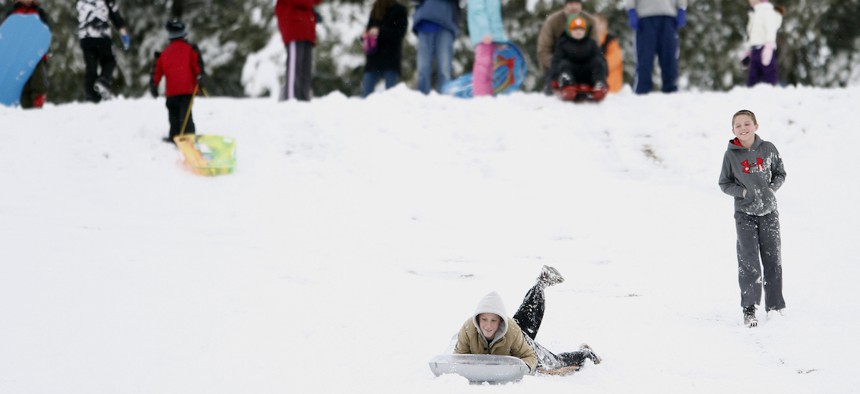How a School District Did Away with Snow Days

The district is the first of five in South Carolina to launch a pilot program replacing inclement weather closures with remote lessons. AP
In Anderson, South Carolina, school officials traded inclement weather closures for remote learning.
When Tropical Storm Michael drove through Anderson, S.C. last October, school was canceled—but students still attended class.
That windy Thursday was Anderson School District 5’s first eLearning day, the launch of a pilot program where inclement weather cancellations are replaced by remote schooling. Students log onto school-provided laptops to complete 200 minutes of activities and lessons—enough to qualify as a day of attendance under state law, avoiding a snow day that has to be made up at a later date.
“Why would we want to make up that day by tacking it on after spring break or at the end of the year, when testing has already happened and we know attendance is very poor?” said Anna Baldwin, director of eLearning and integration for the northwestern South Carolina school district. “We were equipped to try this, so it just made sense for us to be able to do it.”
Anderson implemented the program this year as a pilot, the first of five school districts in South Carolina to do so. The move, approved by the state’s Education Oversight Committee, was prompted by Anderson School District 5 Superintendent Thomas Wilson, who saw e-learning announcements pop up amid traditional school cancellation bulletins while traveling through the Atlanta airport during inclement weather. Intrigued by the prospect, he asked district officials to research whether it would work in Anderson.
It was possible, officials determined, largely thanks to the district’s existing IT infrastructure, most notably its $11 million investment in Google Chromebook laptops for students. Pupils in grades three through 12 take their Chromebooks home each day, while kindergarten through second graders tote theirs home only if the district anticipates an inclement weather closure.
Chromebooks do not require internet access, which allows students to participate in eLearning even if they don’t have internet at home, Baldwin said. If inclement weather looms, teachers can have students download lessons at school before heading home for the day, then complete them later.
“We typically know ahead of time when it’s coming, so we’re able to prepare our teachers,” Baldwin said. “We tell them, ‘We’ll have an eLearning day, you’ll want to start prepping your lesson, what you think you might cover, and then put it in Google Classroom so the students can find their work.’ ”
Teachers are available for online consultation during predetermined blocks of time on eLearning days, the only part of the process that does require an internet connection (though there’s also an app that works on even low-tech smartphones, Baldwin said). All students have five days to complete eLearning assignments, leaving time to get additional help from teachers if necessary or in case a power outage or a machine malfunction derails the homework process.
So far, the district has had two eLearning days—the hurricane pass in October, and an ice storm in December. Online attendance for all 13,000 students averaged around 75 percent for the first day and 70 for the second, with middle- and high-school numbers lagging behind the elementary schools. That’s partially due to the attendance policies in the higher grades, Baldwin said.
“In middle and high school, you get counted present by class period,” she said. “So if the student has four class periods and they complete three of the four assignments, they’re counted as absent for the entire day. I’m not terribly disappointed by the numbers, but we have areas to work on. I don’t think that number truly reflects our attendance.”
Officials will find out in the coming days if the program has been approved by the state for another year, with potential expansions to allow participating districts to better share tips and ideas about things that have worked and things that could be improved. In district 5, feedback has been generally positive—though parents and teachers are, naturally, more enthusiastic than students.
“The parents love knowing in advance that they don’t have to get up and get their kids out on icy roads. They like that they’re not waiting to hear whether school will be open,” she said. “So our parents have been very positive. The kids, well, they’re not as crazy about it.”
Kate Elizabeth Queram is a Staff Correspondent for Route Fifty and is based in Washington, D.C.
NEXT STORY: White House launches AI portal





